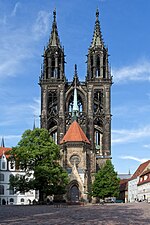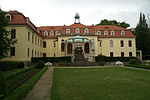Battle of Meissen
1759 in the Holy Roman Empire18th century in SaxonyAustrian battle stubsBattles in SaxonyBattles involving Austria ... and 5 more
Battles involving PrussiaBattles of the Seven Years' WarBattles of the Silesian WarsConflicts in 1759German battle stubs
The Battle of Meissen (4 December 1759) was an Austrian victory over a smaller Prussian force during the Third Silesian War (part of the Seven Years' War). An Austrian force under the command of general Beck assaulted 3,500 Prussian troops under Diericke at Meissen, overwhelming them and driving the survivors across the Elbe. The Prussians lost 400 men in the action and 1,543 fell prisoner. Austrian losses were few, totalling only 72 killed and 115 wounded. The Austrians secured an important victory, which effectively kept their ally Saxony in the war.
Excerpt from the Wikipedia article Battle of Meissen (License: CC BY-SA 3.0, Authors).Battle of Meissen
Elberadweg,
Geographical coordinates (GPS) Address Nearby Places Show on map
Geographical coordinates (GPS)
| Latitude | Longitude |
|---|---|
| N 51.1636 ° | E 13.4775 ° |
Address
Elberadweg
Elberadweg
01662 , Niederfähre
Saxony, Germany
Open on Google Maps









